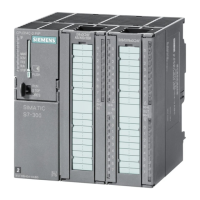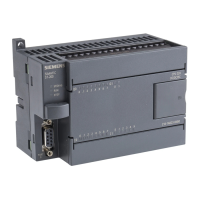Programming concepts
5.8 Program edit in RUN mode
S7-200 SMART
System Manual, 09/2015, A5E03822230-AC
113
To help you decide whether to download your program modifications to the PLC in RUN
mode or STOP mode, consider the following effects from various types of program
modifications made during a RUN mode edit:
● If you delete the control logic for an output, the output maintains its last state until the next
power cycle or transition to STOP mode.
● If you delete HSC, Motion, or PLS functions that were running at the time of the edit in
RUN mode, then these functions continue to run until the next power cycle or transition to
STOP mode.
● If you delete ATCH or DTCH instructions in a RUN mode edit but do not delete the
associated interrupt routine, then the interrupt routine continues to execute whenever the
controlling event occurs until the next power cycle or transition to STOP mode.
● If you add ATCH instructions that are conditional on the first scan flag, the CPU does not
enable these events until the next power cycle or STOP-to-RUN mode transition.
● If you delete an ENI or DISI instruction, activated interrupt routines events still continue to
operate until the next power cycle or transition from RUN to STOP mode.
● If you modify the table address of a RCV instruction and the RCV instruction is active at
the time of the edit in RUN mode, then the PLC writes the received data to the old table
address. The PLC does not use the new address until the current receive request (to the
old address) completes. Because you have edited your program, if the program looks for
the data in the new address, the data will not be there. GET and PUT instructions
function similarly.
● The PLC does not execute logic that is conditional on the first scan flag until after a power
cycle or a transition from STOP to RUN mode. The startup of the modified program after
a RUN mode edit does not set the first scan flag.
Handling positive or negative transitions
To minimize the process impact of changes that involve the relocation of positive transition
(EU) and negative transition (ED) instructions in your program during a RUN mode edit,
STEP 7-Micro/WIN SMART temporarily allocates a number to each transition instruction
included in your program. For each transition instruction that you add in your program during
a RUN mode edit, you must assign it a unique identification number. To assist you in
selecting an unused number, STEP 7-Micro/WIN SMART provides an edge usage tab on the
cross reference window, available when you activate the Program Edit in RUN Mode feature.
This table lists all EU/ ED instructions that are currently in use in your program, so you can
use this list to guide you in making changes to your program.

